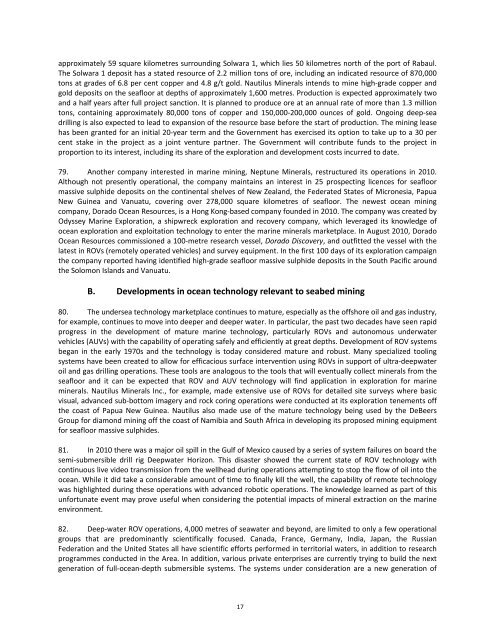Selected Decisions and Documents of the Seventeenth Session ...
Selected Decisions and Documents of the Seventeenth Session ...
Selected Decisions and Documents of the Seventeenth Session ...
Create successful ePaper yourself
Turn your PDF publications into a flip-book with our unique Google optimized e-Paper software.
approximately 59 square kilometres surrounding Solwara 1, which lies 50 kilometres north <strong>of</strong> <strong>the</strong> port <strong>of</strong> Rabaul.<br />
The Solwara 1 deposit has a stated resource <strong>of</strong> 2.2 million tons <strong>of</strong> ore, including an indicated resource <strong>of</strong> 870,000<br />
tons at grades <strong>of</strong> 6.8 per cent copper <strong>and</strong> 4.8 g/t gold. Nautilus Minerals intends to mine high‐grade copper <strong>and</strong><br />
gold deposits on <strong>the</strong> seafloor at depths <strong>of</strong> approximately 1,600 metres. Production is expected approximately two<br />
<strong>and</strong> a half years after full project sanction. It is planned to produce ore at an annual rate <strong>of</strong> more than 1.3 million<br />
tons, containing approximately 80,000 tons <strong>of</strong> copper <strong>and</strong> 150,000‐200,000 ounces <strong>of</strong> gold. Ongoing deep‐sea<br />
drilling is also expected to lead to expansion <strong>of</strong> <strong>the</strong> resource base before <strong>the</strong> start <strong>of</strong> production. The mining lease<br />
has been granted for an initial 20‐year term <strong>and</strong> <strong>the</strong> Government has exercised its option to take up to a 30 per<br />
cent stake in <strong>the</strong> project as a joint venture partner. The Government will contribute funds to <strong>the</strong> project in<br />
proportion to its interest, including its share <strong>of</strong> <strong>the</strong> exploration <strong>and</strong> development costs incurred to date.<br />
79. Ano<strong>the</strong>r company interested in marine mining, Neptune Minerals, restructured its operations in 2010.<br />
Although not presently operational, <strong>the</strong> company maintains an interest in 25 prospecting licences for seafloor<br />
massive sulphide deposits on <strong>the</strong> continental shelves <strong>of</strong> New Zeal<strong>and</strong>, <strong>the</strong> Federated States <strong>of</strong> Micronesia, Papua<br />
New Guinea <strong>and</strong> Vanuatu, covering over 278,000 square kilometres <strong>of</strong> seafloor. The newest ocean mining<br />
company, Dorado Ocean Resources, is a Hong Kong‐based company founded in 2010. The company was created by<br />
Odyssey Marine Exploration, a shipwreck exploration <strong>and</strong> recovery company, which leveraged its knowledge <strong>of</strong><br />
ocean exploration <strong>and</strong> exploitation technology to enter <strong>the</strong> marine minerals marketplace. In August 2010, Dorado<br />
Ocean Resources commissioned a 100‐metre research vessel, Dorado Discovery, <strong>and</strong> outfitted <strong>the</strong> vessel with <strong>the</strong><br />
latest in ROVs (remotely operated vehicles) <strong>and</strong> survey equipment. In <strong>the</strong> first 100 days <strong>of</strong> its exploration campaign<br />
<strong>the</strong> company reported having identified high‐grade seafloor massive sulphide deposits in <strong>the</strong> South Pacific around<br />
<strong>the</strong> Solomon Isl<strong>and</strong>s <strong>and</strong> Vanuatu.<br />
B. Developments in ocean technology relevant to seabed mining<br />
80. The undersea technology marketplace continues to mature, especially as <strong>the</strong> <strong>of</strong>fshore oil <strong>and</strong> gas industry,<br />
for example, continues to move into deeper <strong>and</strong> deeper water. In particular, <strong>the</strong> past two decades have seen rapid<br />
progress in <strong>the</strong> development <strong>of</strong> mature marine technology, particularly ROVs <strong>and</strong> autonomous underwater<br />
vehicles (AUVs) with <strong>the</strong> capability <strong>of</strong> operating safely <strong>and</strong> efficiently at great depths. Development <strong>of</strong> ROV systems<br />
began in <strong>the</strong> early 1970s <strong>and</strong> <strong>the</strong> technology is today considered mature <strong>and</strong> robust. Many specialized tooling<br />
systems have been created to allow for efficacious surface intervention using ROVs in support <strong>of</strong> ultra‐deepwater<br />
oil <strong>and</strong> gas drilling operations. These tools are analogous to <strong>the</strong> tools that will eventually collect minerals from <strong>the</strong><br />
seafloor <strong>and</strong> it can be expected that ROV <strong>and</strong> AUV technology will find application in exploration for marine<br />
minerals. Nautilus Minerals Inc., for example, made extensive use <strong>of</strong> ROVs for detailed site surveys where basic<br />
visual, advanced sub‐bottom imagery <strong>and</strong> rock coring operations were conducted at its exploration tenements <strong>of</strong>f<br />
<strong>the</strong> coast <strong>of</strong> Papua New Guinea. Nautilus also made use <strong>of</strong> <strong>the</strong> mature technology being used by <strong>the</strong> DeBeers<br />
Group for diamond mining <strong>of</strong>f <strong>the</strong> coast <strong>of</strong> Namibia <strong>and</strong> South Africa in developing its proposed mining equipment<br />
for seafloor massive sulphides.<br />
81. In 2010 <strong>the</strong>re was a major oil spill in <strong>the</strong> Gulf <strong>of</strong> Mexico caused by a series <strong>of</strong> system failures on board <strong>the</strong><br />
semi‐submersible drill rig Deepwater Horizon. This disaster showed <strong>the</strong> current state <strong>of</strong> ROV technology with<br />
continuous live video transmission from <strong>the</strong> wellhead during operations attempting to stop <strong>the</strong> flow <strong>of</strong> oil into <strong>the</strong><br />
ocean. While it did take a considerable amount <strong>of</strong> time to finally kill <strong>the</strong> well, <strong>the</strong> capability <strong>of</strong> remote technology<br />
was highlighted during <strong>the</strong>se operations with advanced robotic operations. The knowledge learned as part <strong>of</strong> this<br />
unfortunate event may prove useful when considering <strong>the</strong> potential impacts <strong>of</strong> mineral extraction on <strong>the</strong> marine<br />
environment.<br />
82. Deep‐water ROV operations, 4,000 metres <strong>of</strong> seawater <strong>and</strong> beyond, are limited to only a few operational<br />
groups that are predominantly scientifically focused. Canada, France, Germany, India, Japan, <strong>the</strong> Russian<br />
Federation <strong>and</strong> <strong>the</strong> United States all have scientific efforts performed in territorial waters, in addition to research<br />
programmes conducted in <strong>the</strong> Area. In addition, various private enterprises are currently trying to build <strong>the</strong> next<br />
generation <strong>of</strong> full‐ocean‐depth submersible systems. The systems under consideration are a new generation <strong>of</strong><br />
17

















